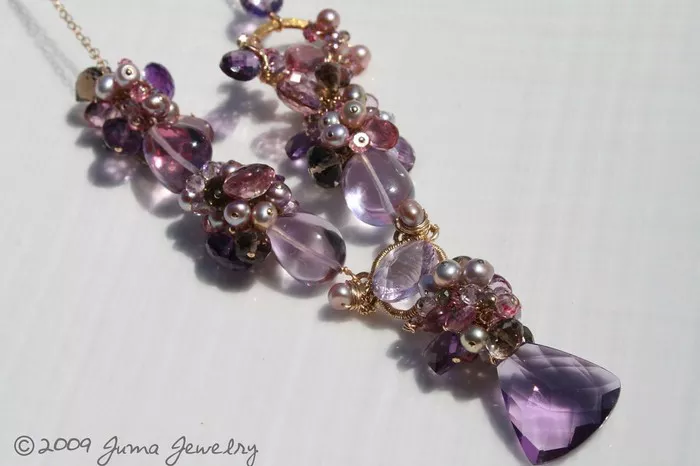Amethyst clusters are natural formations of amethyst crystals grouped together. They are highly sought after for their beauty and can be used in various forms of jewelry and as decorative items. However, with the market flooded with imitations and treated stones, it is crucial to know how to distinguish real amethyst clusters from fake or misrepresented ones.
Visual Inspection
Color
Color is one of the first and most obvious characteristics to consider. A real amethyst cluster typically has a natural – looking purple color. The color should be somewhat uneven in distribution, as it is formed in nature. It can range from a light lilac to a deep purple. In contrast, synthetic or fake amethyst may have a very uniform color that looks “too perfect.” Some fake amethyst clusters may be dyed, and the dye may not penetrate evenly, leaving tell – tale signs such as darker or lighter patches in unexpected areas. For example, if the color seems to be concentrated only on the outer surface of the crystals while the interior is a different color, it could be a sign of a dyed or artificial product.
Crystal Structure
Examining the crystal structure is essential. Real amethyst crystals in a cluster have a distinct geometric shape. They usually form in a six – sided prism shape with a pointed termination at the end. The crystals should be well – formed and not look overly “sloppy” or irregular in a way that is not characteristic of natural crystal growth. In a real amethyst cluster, the crystals are often intergrown with each other in a natural pattern. Fake amethyst may have crystals that are misshapen or lack the proper symmetry associated with natural quartz crystals. Additionally, the angles between the crystal faces should be consistent with the trigonal crystal system of quartz.
Inclusions
Inclusions are a key feature. Natural amethyst clusters almost always have some inclusions. These can be small mineral grains, gas bubbles, or other imperfections. The presence of inclusions is actually a sign of authenticity, as it is difficult to replicate these natural imperfections in synthetic or fake amethyst. When looking closely at an amethyst cluster, one may see tiny specks or cloudy areas within the crystals. However, too many or very large inclusions may also affect the quality and value of the cluster.
Physical Properties
Hardness
Amethyst has a Mohs hardness of about 7. One can perform a simple hardness test (although this should be done with caution). Using a known hardness material, such as a piece of quartz or a steel nail, one can try to scratch the surface of the amethyst cluster. If the cluster is scratched easily by a material with a lower hardness than 7, it is likely not real amethyst. For example, if a fingernail (hardness of about 2.5) can scratch the surface, it is definitely not amethyst. However, this test should be done carefully as scratching can damage the specimen.
Density
Density can also be a useful factor. Amethyst has a relatively high density compared to some fake materials. While it is not easy to measure the density accurately without specialized equipment, a rough estimate can be made. A real amethyst cluster will feel heavier in the hand compared to a similar – sized fake made of a lighter material. For example, if a plastic – made fake amethyst cluster is compared to a real one, the real amethyst will be noticeably denser.
Specialized Tests
UV Light Examination
Under ultraviolet (UV) light, real amethyst may exhibit certain fluorescence characteristics. Some amethysts may fluoresce a faint orange or yellow color under UV light. However, this is not a universal characteristic, and not all amethysts will fluoresce. But if a supposed amethyst cluster shows a very strong or unusual fluorescence that is not typical of amethyst, it could be a sign of a synthetic or treated stone. For example, if it fluoresces a bright blue or green color that is not known for natural amethyst, it is suspect.
Spectroscopy
Spectroscopic analysis is a more advanced method. It can be used to determine the chemical composition of the amethyst. In a real amethyst, spectroscopy will show the presence of silicon dioxide (SiO₂) as the main component, along with trace elements such as iron which gives it the purple color. If a spectroscopic analysis reveals the presence of elements or compounds that are not typical of amethyst, it is likely a fake or a treated stone. This test is usually carried out in a laboratory setting.
Source and Provenance
Geological Origin
Knowing the geological origin of an amethyst cluster can also help in determining its authenticity. Different regions produce amethyst with characteristic features. For example, amethyst from Brazil may have different color intensities or crystal habits compared to amethyst from Uruguay. If a seller claims that an amethyst cluster is from a particular region but it does not exhibit the expected characteristics of that region’s amethyst, it could be a sign of a misrepresentation.
Documentation and Certification
Reputable dealers often provide documentation or certification for their amethyst clusters. This can include details about the origin, treatment (if any), and authenticity. If a cluster comes with proper documentation from a well – known and reliable source, it is more likely to be real. However, one should still verify the information on the documentation through other means, such as visual inspection and basic physical property tests.
Conclusion
Determining the authenticity of an amethyst cluster requires a combination of visual inspection, consideration of physical properties, and in some cases, specialized tests. By carefully examining the color, crystal structure, inclusions, and other factors, one can make a more informed judgment about whether an amethyst cluster is real or not.
Related topic:
- Amethyst: What to Avoid and How to Preserve Its Value
- Can You Wear Amethyst and Yellow Sapphire Together?
- The Ideal Placement and Value Appreciation of Amethyst in Jewelry


